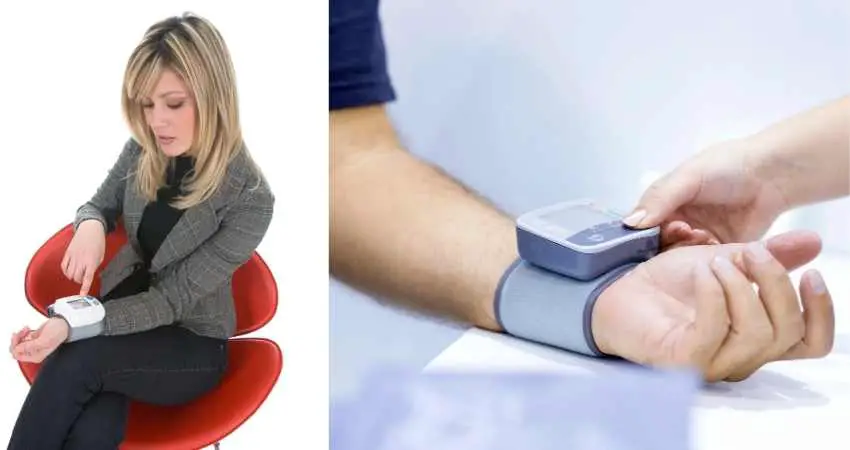Many people don’t consider which wrist to measure their blood pressure on. Typically whatever one is more convenient is the wrist most used. The choice you select is critical to your measurements. This is why everyone should know the answer to. What wrist should you take your blood pressure on?
The American Heart Association states the first time a blood pressure measurement is taken, both wrists should be used. The measurements should be compared, and the higher number measurement wrist should be used to take your blood pressure for all subsequent measurements.
Technically, they use the term arm, but the wrist is part of the arm and the procedure is the same for an arm or wrist. By failing to measure your blood pressure in both wrists can be a fatal decision. In addition for proper monitoring of your pressure, it can help diagnosis a significant health issue which I’ll explain further in this article.
BP TIP: I’ve also uncovered a simple way to lower BP by just breathing. It’s FDA approved and The American Heart Association gave it the thumbs up. It simply guides your breathing for you a few minutes a day which has been proven to lower blood pressure as shown in studies. You can check it out in the manufacturer’s website by clicking here.
Disclaimer: Some of links in this article are affiliate links which means I may earn a small commission at no extra cost to you. As an Amazon associate I earn from qualifying purchases.
( Lower Your BP Naturally, In Only 30 Days Or Pay Nothing…Visit Website By Clicking Here Or Photo Above )
Which Wrist Do You Take Your Blood Pressure On?
It’s typical to have different measurements in both wrists. Differences less than 10 mmHg are the norm and typically are not a problem. The American Collage of Cardiology and The American Heart Association states in their latest guidelines both arms should be used at an initial physician visit1. The wrist with the higher measurement should then be used on all visits after.
These two are not the only major institutions, Harvard Health Publishing also states blood pressure should be taken in both arms. They also state the arm with the higher pressure should be the one used to base treatments on and the one to check blood pressure in the future2.
The Texas Heart Institute published, the arm with the higher blood pressure should be used for all subsequent measurements. They stressed the importance of this and explained how a misdiagnosis can occur if the wrong arm is used3.
The Consequences of Using The Wrong Wrist for Blood Pressure
Misdiagnosis of High or Low Blood Pressure
First I’ll explain how taking your pressure only on one wrist can miss a diagnosis of high blood pressure. Let’s say you only check the left wrist and your readings are always 119/79. Unknown to you, the pressure in your right wrist is 131/83 which indicates your blood pressure is high4.
Now in the same scenario let’s say the pressure in your right wrist is 107/69. Since you’re only checking the left wrist you wouldn’t know the pressure in the other wrist is lower. While 107/69 is not considered low pressure, it wouldn’t warn you of a potential pattern towards low blood pressure.
Failure to measure and record your measurements in both arms may help prevent a diagnosis of low or high blood pressure. At your next physician visit, the doctor would only be given part of your actual blood pressure patterns and recordings and not the complete picture.
Here’s an interesting story. A 69 year-old woman was admitted into the hospital for surgery. Different nurses measured her pressure at different times and each nurse used a different arm. Her second reading was so much lower, they assumed her blood pressure dropped and thought her body was reacting to an infection. Little did they know at the time, her pressure never lowered and remained consistent. The pressure was lower in one arm and higher in the other.
Because the nurses used different arms, it caused them to think the patient’s pressure dropped when it didn’t. The patient received two days of medication and treatment she didn’t really need. It turned out the patient had a narrowing of an artery on one side of her body causing the difference in blood pressure between the two arms3.
Failure to Diagnose a Serous Medical Problem
If only one wrist is checked and the other measurement has a large difference, you wouldn’t be aware of it. Why is this important for your health? A larger difference between both arms can mean there’s a severe medical problem. The following are possible conditions when this occurs.
Aortic dissection: Although it’s very rare, it could be the problem. An aortic dissection is when the inner wall of the aorta tears. Blood flows through the tear and between the inner and outer wall causing the layers to separate. If the blood in this area breaks through the outer wall, more often the results are fatal5.
Peripheral Artery Disease: A blood pressure difference between the wrists may indicate this disease (PAD) is present. It’s a circulation problem in which the arteries serving the stomach, legs, arms and head narrows. If PAD is diagnosed early, it may be treated with medication or changes in diet and exercise. Longer term it may lead to a high risk of heart attack, stroke and coronary artery disease6.
Disruption of Blood Flow in Younger People: Blood flow through an artery may be blocked or restricted for a few reasons. There may be a bone or muscle pressing down on the artery. In addition a structural problem may restrict blood flow. A disruption of blood flow on one side of the body may cause a different measurement in the wrist on that side of the body.

Avoid This Mistake When You Take Blood Pressure at the Wrist
Now that you know what wrist to use when taking your blood pressure, I want you to avoid the biggest mistake people make. Also, why are you using a wrist monitor? If it’s not for the reasons I talk about in this blog post, Are Wrist Blood Pressure Monitors Accurate? You may want to avoid using the wrist monitor in the future. I also explain why in the same blog post.
If you do require a wrist cuff monitor, you may want to check out the one I recommend here in my blog post review, Wrist Monitors.
The mistake many people make is having the cuff in the wrong position when measuring. It should be at heart level and your arm position is also important when setting up your measurement.
- Rest the elbow on a comfortable surface.
- Raise your wrist to heart level.
- Keep your wrist straight and don’t bend it forward or backward.
- The tension in your wrist and hand should remain relaxed enough to keep it straight and not tensed.
- If you choose not to use a flat surface for the elbow, ensure your arm is supported another way.
There are more wrist cuff tips which I explain in complete detail in my next blog post, How To Use a Wrist Blood Pressure Cuff.
Wrapping Up
The importance of choosing the correct wrist when taking your blood pressure is critical. If the wrong wrist is chosen, you may misdiagnose your pressure as too high or low when it really isn’t.
Failure not to use both wrists initially, may cause you not to realize a bigger medical issue is present. Some of the medical experts suggest checking both arms every year to make sure your typical difference between the two remain the same.
Of course, you can’t do any of this if you’re not monitoring your pressure at home. Home monitoring can help your physician make an earlier diagnosis of high blood pressure then if you only have it measured once a year under less than ideal surroundings. I’m not sure about you, but I’m totally unrelaxed when I’m at a doctor’s office. So get yourself a monitor and give home monitoring a try!

- Journal of The American College of Cardiology: 2017 Guideline for the Prevention, Detection, Evaluation, and Management of High Blood Pressure in Adults [↩]
- Harvard Health Publishing: Big arm-to-arm difference in blood pressure linked to higher heart attack risk [↩]
- National Center for Biotechnology Information: Accurate Blood Pressure Measurements and the Other Arm [↩] [↩]
- American Heart Association: Understanding Blood Pressure Readings [↩]
- Journal Circulation: Aortic Dissection [↩]
- The American Heart Association: Peripheral Artery Disease (PAD) [↩]
